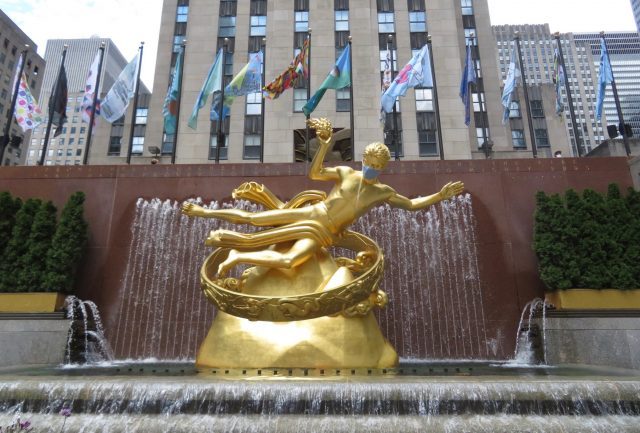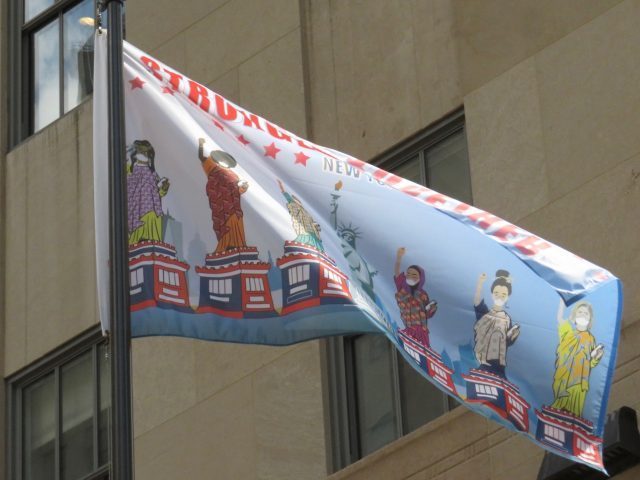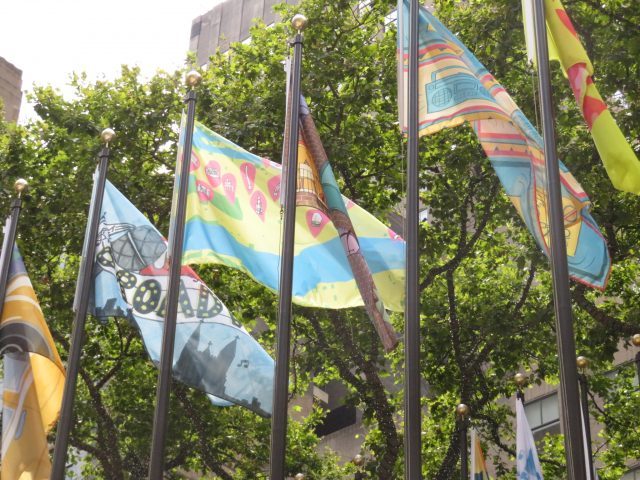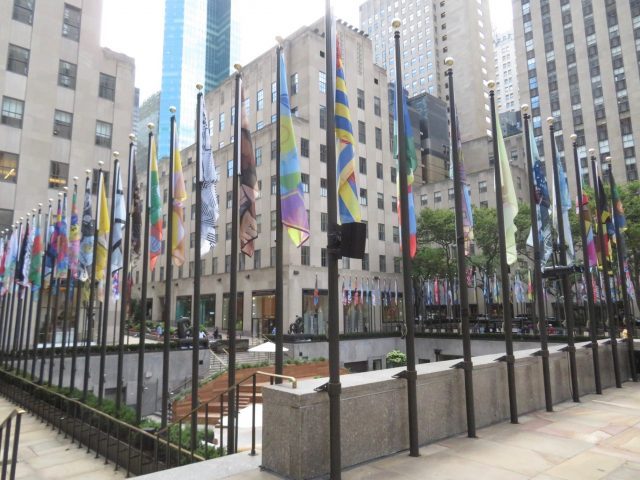
A masked Prometheus rules over flags at Rockefeller Center celebrating the resiliency of New York City (photo by twi-ny/mdr)
The Rink at Rockefeller Center
Forty-Ninth to Fiftieth Sts. between Fifth & Sixth Aves.
Daily through August 16, free
www.rockefellercenter.com
Flags are more political than ever these days, generating heated arguments about the meaning of Confederate symbols, kneeling during the playing of “The Star-Spangled Banner” at sports events, and even President Trump’s refusal to order flags to half-staff for coronavirus victims until the death toll headed toward one hundred thousand.

Ohio State University computer science student Henos Efrem depicts diversity and solidarity in his flag (photo by twi-ny/mdr)
Rockefeller Center is using flags as a way to heal the city with “The Flag Project,” continuing through August 16 around the periphery of the skating rink, which is currently being used as a place of respite, offering delightful socially distant seating, drinks, and food from the Rainbow Room barbecue booth. (Make sure you wear your mask down there; even golden Prometheus’s face is covered.) Rock Center is usually surrounded by 193 flags, one for each member country in the United Nations. But for just more than two weeks, those have been replaced by flags designed by emerging and established artists, adults and children, to honor how New Yorkers have come together during the pandemic lockdown. Each eight-foot-by-five-foot flag boasts a design celebrating essential workers, the uniqueness of the Big Apple, and/or hope for a promising future. Many of the flags are accompanied by an artist statement you can find on this map.

“The Flag Project” continues at Rockefeller Center through August 16 (photo by twi-ny/mdr)
“Flags are employed to guide people through uncertain or dangerous situations. They can be used as a means of communication, signaling, or a way to unite people, for better or for worse,” Marina Abramović says about her contribution, a staggered red line on a white background. “I created a flag which represents the echocardiography (EKG) line of the human heartbeat. . . . The EKG line of my flag represents the resilience of the human spirit in the color red, which symbolizes our blood and is a color I often surround myself with when I need to feel strong. This red line beats across the white flag, which symbolizes surrender. In this moment in human history, I believe we as a society must conduct ourselves with a balance of strength and surrender. We must be strong in the face of the unknown and at the same time we must surrender to changes demanded of society, our politics, and our planet.”
Other commissioned artists include Carmen Herrera, Christian Siriano, Hank Willis Thomas, Jeff Koons, Jenny Holzer, KAWS, Laurie Anderson, Sanford Biggers, Sarah Sze, Shantell Martin, Steve Powers, and Faith Ringgold, who pays homage to “the life & Breath of Freedom” in her red, white, and blue quiltlike creation.
The flags are, of course, more impressive when there’s some wind blowing them around, allowing them to unfurl; be on the lookout for Ien Boodan’s Henri Matisse- and Keith Haring-inspired design based on “La danse” (“My wish is to have other queer brown boys and girls see this flag waving in public space so that they may know that their bodies are worthy of representation, pleasure, and celebration,” he notes), Karen Margolis’s tiny burned cells (“I explore the changing landscape of both our physical and internal worlds through the arbitrariness of destruction and loss”), Kate Matthiesen’s vivid abstract painting (her intensity takes on greater meaning since she hails from Portland, Oregon), Mario Milosevic’s repetitive half-circles, which support immigrants, language, and unity (“The gradient symbolizes skin tones and diversity, while five color stripes represent five boroughs”), Jonathan Rockefeller’s bright, shining cityscape, Courtney Heather’s group of sneakered feet on a subway near a plastic bag, and Vlad Zadneprianski’s NYC Strong flag, in which masked superheroes are joined by an essential healthcare worker. You’ll also find depictions of Coney Island, sports and cultural events, the Statue of Liberty, water towers, bridges, a salted pretzel, Broadway, mass transit, skyscrapers, a pigeon, and other familiar city sights.

“The Flag Project” features 193 specially designed flags temporarily replacing those of UN countries (photo by twi-ny/mdr)
“Our flag is not just one of many political points of view. Rather, the flag is a symbol of our national unity,” said U.S. Air Force Radio and Television Broadcasting Specialist Adrian Cronauer, best known as the man Robin Williams portrayed in the 1987 film Good Morning, Vietnam.
“A thoughtful mind, when it sees a Nation’s flag, sees not the flag only, but the Nation itself,” longtime Brooklynite Henry Ward Beecher proclaimed. In these flags, one can see the whole of New York as it rises yet again through unimaginable diversity and tragedy, once more a microcosm of America.